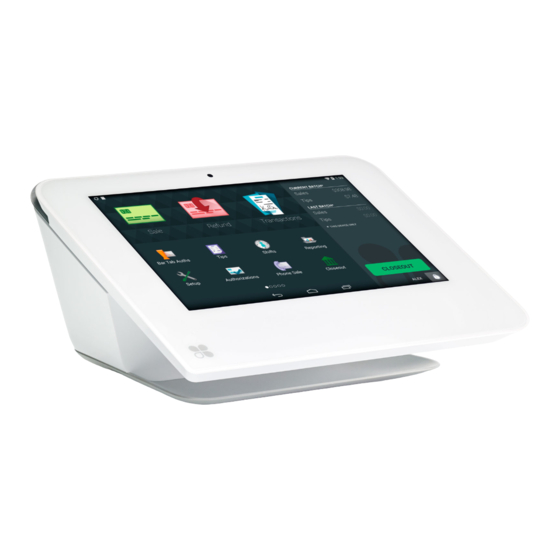
Clover Mini Security Policy
Hide thumbs
Also See for Mini:
- Features manual (11 pages) ,
- Install manual (8 pages) ,
- User manual (2 pages)
Advertisement
Advertisement

Summary of Contents for Clover Mini
- Page 1 Clover Mini Security Policy Clover Mobile Security Policy...
-
Page 2: Table Of Contents
Table of Contents INTRODUCTION GENERAL DESCRIPTION INSTALLATION GUIDANCE VISUAL SHIELDING DEVICE SECURITY DECOMMISSIONING KEY MANAGEMENT SYSTEM ADMINISTRATION Clover Mobile Security Policy... -
Page 3: Introduction
General description 1. Product overview a. Clover Mini (see image 1) is designed as a pin entry device (PED) to facilitate credit and debit based transaction. The device is only approved for use in an attended environment. This device has a color LCD with touch screen as the customer interface for PIN entry. - Page 4 This device uses cryptologic authentication on all code before execution. 3. Device Identification a. Identifying information is presented on the label inside the printer as seen in Image 2 and 3. Clover Mobile Security Policy...
- Page 5 4. Version Information a. Software and firmware are displayed on the settings section on the device. The user should regularly check the software and firmware version of the device. b. From the main screen, click on “Settings” Clover Mobile Security Policy...
- Page 6 Click on “About tablet” d. View version numbers Clover Mobile Security Policy...
-
Page 7: Installation Guidance
WPA or WPA2. c. Once connected, the end user must enter a one-time security code provided by Clover. This code is communicated via a different communication channel than the device itself. d. Once the code is verified against the requesting device, the device shall perform security updates including injection of security keys. - Page 8 Clover Mobile software implements PCI security requirements for authenticated applications. b. No external developers are permitted to touch unencrypted payment data. Clover makes certain that this data is already encrypted immediately, that no clear-text data is outputted, and that all applications are signed.
-
Page 9: Visual Shielding
1. The device comes with a PIN Shield and supplied instructions on the proper installation and use. Use of the device for PIN Entry without the supplied PIN shield will invalidate the PCI PTS approval. The custom PIN Shield lays over the screen as follows: Clover Mobile Security Policy... -
Page 10: Device Security
PIN entry. C. Surveillance cameras sited around the POS PED device must be positioned such that they cannot record the PIN number as it is entered. Device Security 1. Roles Clover Mobile Security Policy... -
Page 11: Decommissioning
No changes to the resistance when inserting or removing a card from the ICC slot. Decommissioning 1. To decommission your device, a factory reset will remove the payment keys in the device. A device may then be provisioned to a new user. Clover Mobile Security Policy... - Page 12 From the main screen select “Settings”: b. Select the “Backup & reset” option: Clover Mobile Security Policy...
- Page 13 Select “Factory data reset”: d. Select “Reset device”: Clover Mobile Security Policy...
- Page 14 Enter your assigned employee pin: f. Select “Erase everything”: Clover Mobile Security Policy...
-
Page 15: Key Management
2. If a device’s tamper mechanism has been tripped, the device’s keys have been erased and the device needs to be returned to Clover. 3. If a device is damaged in any way that prevents the user from checking the commissioning status of the device, the device needs to be returned to Clover. - Page 16 MB SBK. ii. Secure Board (SB) - the secure board uses 256 bit ECDSA to validate code. The secure board is protected by the Clover Root Key (CRK). The CRK is validated by the Maxim Root Key (MRK).
- Page 17 Intermediate Validate authenticity of SRED RSA Cert Keypair key (in case of RSA Transamor) 2048 SB ROM TransArmor Keypair Encrypt SRED data 2048 SB RAM PIN IPEK Initialize DUKPT key table 3DES 112 Maxim 32550 NVS Clover Mobile Security Policy...
- Page 18 Integrity protection of MB kernel 2048 MB Bootloader Allows loading of signed debug Debug block blob 2048 MB ROM Clover Developer Validates authenticity of Clover- Keypair developed non-system apps 2048 MB ROM Clover Platform App Validation Authenticity of Android platform...
-
Page 19: System Administration
Validation Authenticity of non-platform Keypair Android apps 2048 MB ROM Clover APK Validation Keypair Authenticity of Clover Store Apps 2048 MB ROM Clover Server Identifies Clover's servers to Keypair device 2048 MB ROM Clover Offline Signs CAPKs, Revoked CAPKs and...
















Need help?
Do you have a question about the Mini and is the answer not in the manual?
Questions and answers